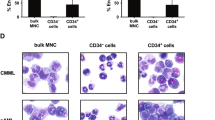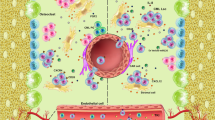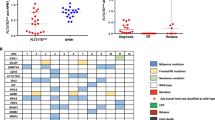Abstract
Human leukemia cell lines are of great value in investigating basic and applied aspects of cell biology and clinical medicine. There have been 37 leukemia cell lines carrying 11q23 translocation and MLL rearrangements; however, cell lines harboring with t(1;11)(p32;q23) have not been established. We report here for the first time a new acute monocytic leukemia (AMoL) cell line with t(1;11)(p32;q23), designated TZ-1, and herein describe its biological characteristics. Mononuclear cells isolated from the ascites from a patient with AMoL (French–American–British classification; acute myeloid leukemia M5a) were isolated and passaged by liquid culture medium for a year. TZ-1 cells revealed typical monocytic features in morphology and had a t(1;11)(p32;q23) translocation. The immunoprofiling as determined by flow cytometry showed that TZ-1 cells are positive for myeloid and monocytic markers with lymphoid-associated markers. Fluorescence in situ hybridization and reverse transcription-polymerase chain reaction analyses revealed MLL-EPS15 fusion transcript and protein. Taken together, these results suggest that TZ-1 is a new monocytic leukemia cell line with t(1;11) translocation and fusion gene MLL-EPS15. The established cell line, TZ-1, could provide a valuable model in the analysis of the pathogenesis of MLL-EPS15-positive leukemia and in the development of new agents for this type of leukemia.
This is a preview of subscription content, access via your institution
Access options
Subscribe to this journal
Receive 12 print issues and online access
$259.00 per year
only $21.58 per issue
Buy this article
- Purchase on Springer Link
- Instant access to full article PDF
Prices may be subject to local taxes which are calculated during checkout





Similar content being viewed by others
References
Rowley JD . The role of chromosome translocation in leukemogenesis. Semin Hematol 1999; 36: 59–72.
Sorensen PHB, Chen CS, Smith FO, Arthur DC, Domer PH, Kersey JH et al. Molecular rearrangements of the MLL gene are present in most cases of infant acute myeloid leukemia and are strongly correlated with monocytic or myelomonocytic phenotypes. J Clin Invest 1994; 93: 429–437.
Rubnitz JE, Behm FG, Downing JR . 11q23 rearrangements in acute leukemia. Leukemia 1996; 10: 74–82.
Haferlach T, Schoch C, Schnittger S, Kern W, Loffler H, Hiddemann W . Distinct genetic patterns can be identified in acute monoblastic and acute monocytic leukemia (FAB AML M5a and M5b): a study of 124 patients. Br J Haematol 1996; 93: 966–972.
Bloomfield CD, Archer KJ, Mrozek K, Lillington DM, Kaneko Y, Head DR et al. 11q23 balanced chromosome aberrations in treatment-related myelodysplastic syndromes and acute leukemia: report from an international workshop. Genes Chromosomes Cancer 2002; 33: 362–378.
Drexler HG, Quentmeier H, MacLeod RAF . Malignant hematopoietic cell lines: in vitro models for the study of MLL gene alterations. Leukemia 2004; 18: 227–232.
Jaffe ES, Harris NL, Stein H, Vardiman JW (eds). Pathology and Genetics of Tumours of Haematopoietic and Lymphoid Tissues. IARC Press: Lyon, France, 2001.
Schoch C, Schnittger S, Klaus M, Kern W, Hiddemann W, Haferlach T . AML with 11q23/MLL abnormalities as defined by the WHO classification: incidence, partner chromosomes, FAB subtype, age distribution, and prognostic impact in an unselected series of 1897 cytogenetically analyzed AML cases. Blood 2003; 102: 2395–2402.
Tsujioka T, Wada H, Yamamori S, Otsuki T, Suemori S, Sugihara T et al. MLL/EPS15 fusion in therapy-related early pre-B acute lymphoblastic leukemia with t(1;11) (p32;q23) translocation developing in the relapse phase of acute promyelocytic leukemia. Int J Hematol 2003; 78: 439–442.
Bernard OA, Mauchauffe M, Mecucci C, Van den Berghe H, Berger R . A novel gene, EPS15, fused to HRX in t(1;11) (p32; q23), is not related to AF-4, AF-9 nor ENL. Oncogene 1994; 9: 1039–1045.
Chen S, Xue Y, Zhang X, Wu Y, Pan J, Ceng J et al. A new human monocytic leukemia cell line SHI-1 with t(6;11)(q27;q23), p53 gene alterations and high tumorigenicity in nude mice. Haematologica 2005; 90: 766–775.
Douet-Guilbert N, Morel F, Le Bris MJ, Herry A, Morice P, De Braekeleer M et al. Rearrangement of the MLL gene in acute myeloblastic leukemia: report of two rare translocations. Cancer Genet Cytogenet 2005; 157: 169–174.
Harrison CJ, Cuneo A, Clark R, Johansson B, Lafage-Pochitaloff M, Mugneret F, et al., on behalf of the European 11q23 Workshop participants. Ten novel 11q23 chromosomal partner sites. Leukemia 1998; 12: 811–822.
Strehl S, Konig M, Mann G, Haas OA . Multiplex reverse transcriptase-polymerase chain reaction screening in childhood acute myeloblastic leukemia. Blood 2001; 97: 805–808.
Secker-Walker LM, Moorman AV, Bain BJ, Mehta AB, on behalf of the EU Concerted Action 11q23 Workshop. Secondary acute leukemia and myeloblastic syndrome with 11q23 abnormalities. Leukemia 1998; 12: 840–844.
Palka G, Calabrese G, Di Girolamo G, Stuppia L, Di Bartolomeo P, Torlontano G et al. Cytogenetic survey of 31 patients treated with bone marrow transplantation for acute nonlymphocytic and acute lymphoblastic leukemias. Cancer Genet Cytogenet 1991; 51: 223–233.
Satake N, Maseki N, Nishiyama M, Kobayashi H, Sakurai M, Kaneko Y . Chromosome abnormalities and MLL rearrangements in acute myeloid leukemia in infants. Leukemia 1999; 13: 1013–1017.
Fazioli F, Minichiello L, Matoskova B, Wong WT, Di Fiore PP . Eps15, a novel tyrosine kinase substrate, exhibits transforming activity. Mol Cell Biol 1993; 13: 5814–5828.
Fazioli F, Wong WT, Ullrich SJ, Sakaguchi K, Appella E, Di Fiore PP . The ezrin-like family of tyrosine kinase substrates: receptor-specific pattern of tyrosine phosphorylation and relationship to malignant transformation. Oncogene 1994; 8: 1335–1345.
Wong WT, Kraus MH, Carlomagno F, Zelano A, Druck T, Di Fiorre PP et al. The human eps15 gene, encoding a tyrosine kinase substrate, is conserved in evolution and maps to 1p31–p32. Oncogene 1994; 9: 1591–1597.
So CW, Lin M, Ayton PM, Chen EH, Cleary ML . Dimerization contributes to oncogenic activation of MLL chimeras in acute leukemias. Cancer Cell 2003; 4: 99–110.
Ayton PM, Cleary ML . Transformation of myeloid progenitors by MLL oncoproteins is dependent on Hoxa7 and Hoxa9. Genes Dev 2003; 17: 2298–2307.
Milne TA, Martin ME, Brock HW, Slany RK, Hess JL . Leukemogenic MLL fusion proteins bind across a broad region of the Hoxa9 locus, promoting transcription and multiple histone modifications. Cancer Res 2005; 65: 11367–11374.
Acknowledgements
We thank Dr Y Enomoto (Department of Pathology, Keio University School of Medicine) for TEM studies, and also thank Ms K Saito for her excellent technical assistance. This research was supported in part by Keio University Grant-in Aid for the Encouragement of Young Medical Scientists, and a grant-in aid from the Ministry of Education, Culture, Sports, Science and Technology of Japan.
Author information
Authors and Affiliations
Corresponding author
Rights and permissions
About this article
Cite this article
Sagawa, M., Shimizu, T., Shimizu, T. et al. Establishment of a new human acute monocytic leukemia cell line TZ-1 with t(1;11)(p32;q23) and fusion gene MLL-EPS15. Leukemia 20, 1566–1571 (2006). https://doi.org/10.1038/sj.leu.2404305
Received:
Revised:
Accepted:
Published:
Issue Date:
DOI: https://doi.org/10.1038/sj.leu.2404305



